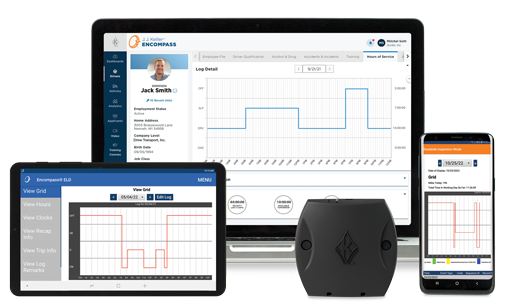Sr. Transportation Safety Editor — J. J. Keller & Associates, Inc.
Debunking Team Driver Myths
Drivers can easily hear a lot of fiction when it comes to the team driving rules. Our experts answer the top five questions about team driving.
Published On: 05/06/2021


Written by:
Jill Schultz
Call it what you may, “truck stop rumor,” “CB gossip,” or “internet myth,” a driver can easily hear a lot of fiction when it comes to the FMCSA rules regarding team driving. Our experts at J. J. Keller are no strangers to these myths. In this week’s blog, they answer the top five most frequently asked questions they receive on team driving.
Can both drivers in the vehicle maintain one record of duty status (log)?
No, the driver’s record of duty status belongs to the driver, not the vehicle. It must reflect the driver’s activities for the day. This can be tricky when using an electronic logging device (ELD). Each driver needs to remember to switch the ELD to his or her record when getting behind the wheel or when needing to record changes in duty status.
Is it true that both drivers cannot be in the same duty status at the same time?
No, a driver’s record of duty status is a true and accurate reflection of his or her activities. For example, if both drivers are off duty at the same time, this should be recorded for each of them. Do keep in mind that an investigator or auditor will look at both drivers’ records to verify accuracy. So, if both drivers are off duty in Denver, but go back on duty in Omaha, there could be an issue.
Can sleeper-berth time be logged as off-duty time?
No, as already stated, the record of duty status must be a true and accurate reflection of the driver’s activities. Time spent in the sleeper-berth and off-duty time must be logged distinctly.
Can a driver log time spent riding in the passenger seat as off-duty time?
Yes, there is one instance in which this can be done. Up to three hours of time in the passenger seat of a moving commercial motor vehicle immediately before or after a sleeper-berth period of at least seven hours may be counted as off-duty time if the sleeper-berth time plus the off-duty time amounts to at least ten consecutive hours. All other instances of riding in the passenger seat of a moving commercial motor vehicle would be logged as on-duty (not driving) time.
Can a team be cited for a messy sleeper berth?
No, law enforcement is not the drivers’ mother and will not require drivers to “clean their room.” With that said, there are some requirements that must be met.
A sleeper berth must meet certain dimension, access, and location requirements as outlined in §393.76 of the Federal Motor Carrier Safety Regulations (FMCSRs). A sleeper berth must have an adequate mattress, bedding, and occupant restraint system. It also must have proper ventilation and protection against vehicle exhaust or fuel leaks from entering the sleeper berth.
Comply with Team Driving Rules with J. J. Keller® ELDs
The Encompass® ELD app makes compliance with hours of service easier for your drivers — including team drivers — with multiple driving rulesets, quick Elog annotation entry, easy log editing, and eDVIRs. Talk with a compliance specialist today about the flexibility of the Encompass® ELD app. Learn more.
You may also enjoy the following articles:
Sign up for our newsletter!
We'll help you stay on top of regulations, best practices, and fleet industry news. Sign up to receive a monthly email notification with links to our most recent blog articles, free resources, and event invites.
